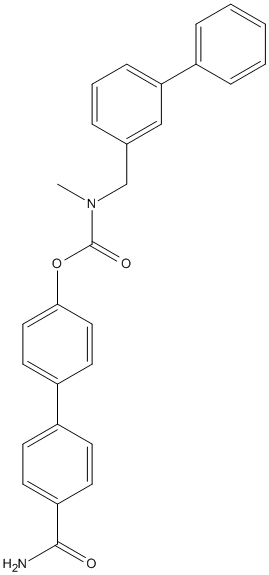WWL123
(Differs from WWL70 only by a phenyl instead of a pyridine). Brain-penetrant inhibitor of ABHD6 hydrolysis of cannabinoid 2-Arachidonylglycerol (IC50 = 0.43 uM). Inhibition of ABHD6 by WWL123 has been used to decrease seizure incidence in a genetic mouse model of juvenile Huntington's disease as well as in chemically-induced epilepsy models. But relation to Cannabinoid pathway discussed. There are discrepencies in the structures presented between 3-yl and 4-yl isomers
General
Type : Carbamate,Biphenyl
Chemical_Nomenclature : [3-(4-carbamoylphenyl)phenyl] N-methyl-N-[(3-phenylphenyl)methyl]carbamate
Canonical SMILES : CN(CC1=CC=CC(=C1)C2=CC=CC=C2)C(=O)OC3=CC=CC(=C3)C4=CC=C(C=C4)C(=O)N
InChI : InChI=1S\/C28H24N2O3\/c1-30(19-20-7-5-10-24(17-20)21-8-3-2-4-9-21)28(32)33-26-12-6-11-25(18-26)22-13-15-23(16-14-22)27(29)31\/h2-18H,19H2,1H3,(H2,29,31)
InChIKey : QKMMESWNJMOPIF-UHFFFAOYSA-N
Other name(s) : WWL-123,WWL 123,SCHEMBL14684640,SR-02000001736,SR-02000001736-1,N-[[1,1'-Biphenyl]-3-ylmethyl)-N-methylcarbamic acid 4'-(aminocarbonyl)[1,1'-biphenyl]-4-yl ester
MW : 436.50
Formula : C28H24N2O3
CAS_number : 1338574-83-6 || 1338575-41-9
PubChem : 53364549
UniChem : QKMMESWNJMOPIF-UHFFFAOYSA-N
IUPHAR :
Wikipedia :

Target
References (2)
| Title : ABHD6 Blockade Exerts Antiepileptic Activity in PTZ-Induced Seizures and in Spontaneous Seizures in R6\/2 Mice - Naydenov_2014_Neuron_83_361 |
| Author(s) : Naydenov AV , Horne EA , Cheah CS , Swinney K , Hsu KL , Cao JK , Marrs WR , Blankman JL , Tu S , Cherry AE , Fung S , Wen A , Li W , Saporito MS , Selley DE , Cravatt BF , Oakley JC , Stella N |
| Ref : Neuron , 83 :361 , 2014 |
| Abstract : Naydenov_2014_Neuron_83_361 |
| ESTHER : Naydenov_2014_Neuron_83_361 |
| PubMedSearch : Naydenov_2014_Neuron_83_361 |
| PubMedID: 25033180 |
| Gene_locus related to this paper: human-ABHD6 , mouse-ABHD6 |
| Title : Genetic deletion of monoacylglycerol lipase alters endocannabinoid-mediated retrograde synaptic depression in the cerebellum - Zhong_2011_J.Physiol_589_4847 |
| Author(s) : Zhong P , Pan B , Gao XP , Blankman JL , Cravatt BF , Liu QS |
| Ref : Journal de Physiologie , 589 :4847 , 2011 |
| Abstract : Zhong_2011_J.Physiol_589_4847 |
| ESTHER : Zhong_2011_J.Physiol_589_4847 |
| PubMedSearch : Zhong_2011_J.Physiol_589_4847 |
| PubMedID: 21911610 |
| Gene_locus related to this paper: human-MGLL , mouse-MGLL |